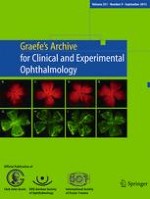Erschienen in:

01.08.2005 | Short Communication
Quantitative assessment of the long-term effect of photodynamic therapy in patients with pathologic myopia
verfasst von:
Ute E. K. Schnurrbusch, Claudia Jochmann, Peter Wiedemann, Sebastian Wolf
Erschienen in:
Graefe's Archive for Clinical and Experimental Ophthalmology
|
Ausgabe 8/2005
Einloggen, um Zugang zu erhalten
Abstract
Background
In patients with classic subfoveal choroidal neovascularization (CNV) secondary to pathologic myopia (PM), photodynamic therapy (PDT) has been shown to stabilize the visual acuity. We have analyzed the long-term visual prognosis after PDT in patients with CNV secondary to PM.
Methods
In a retrospective study we reviewed the clinical charts of 102 patients. PDT was performed following the procedures described in the VIP and TAP study protocols. Follow-up examinations and PDT treatment were scheduled in 3-month intervals. Indications for retreatment were an active leaking CNV in combination with visual disturbances or visual loss. To assess treatment effects we analyzed the number of letters read on the ETDRS charts. The primary efficacy outcome was the proportion of eyes that had fewer than eight letters loss or gain at 24 months. Secondary efficacy outcomes included the proportion of eyes that had fewer than 15 letters loss or gain and the proportion of eyes that had fewer than 30 letters loss or gain at month 24.
Results
One hundred and two patients were included into the study. Mean follow-up was 32.5±5.7 months. Patients received an average of 2.2 treatments from study entry through the last follow-up, resulting in a total of 221 PDT sessions throughout the study. At 24 months 46% lost at least eight letters. A loss of at least 15 (30) letters was observed in 25% (8%). Improvement of at least eight letters was noted in 8%. Larger improvements of at least 15 letters occurred only in 4% of study eyes.
Conclusion
Our study suggests that PDT can increase the chance of stabilizing or improving vision compared with the placebo arm of VIP trial.











